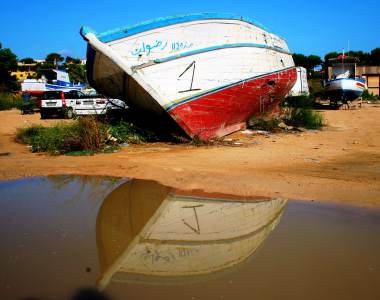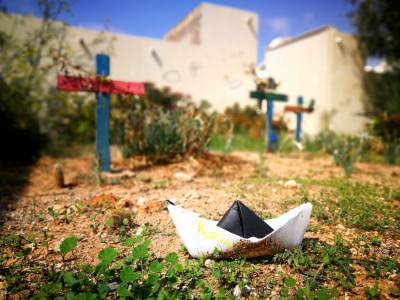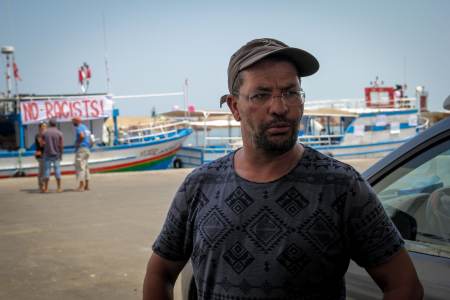The border of Lampedusa. Unlawful practices, indifference and resistance
On Lampedusa, the limbo of a border in the middle of the Mediterranean, the landings of migrants continue uninterrupted. The violations of rights which are constantly carried out in the hotspot – where up to 300 people have been detained in recent days -, the informal European relocation procedures, and the violence constituted by widespread indifference take place under the silence of the media. Nevertheless, opposition to the criminalisation of migrants by associations is the basis for daily resistance on and off the border.
aPhoto by Silvia Di Meo
A border of indifference and resistance
The story which reaches Sicily, two hundred kilometres north of Lampedusa, then Italy and finally Europe, is often analysed through filters that are out of focus and in which only a few elements are framed, the appanage of one or the other side, in the eternal opposition between two sides, between those who want to welcome and those who do not. But is this actually the real story? On the occasion of the last European elections, Lampedusa ended up in all of the newspapers with a single title: it is a boom for the Lega, Salvini’s party that wins out on the island of reception. But the truth – if one can speak of truth – is much more complex: A feeling of hostility, which has always been there, has always existed, but has remained hidden between the lines of the thousands of articles or services of these years ready for the news of the landings and the very strong media coverage that annoys the people of Lampedusa: there is always a single voice that breaks out of its borders.
In fact, in the picture painted for those who are far from that small island in the middle of the Mediterranean, a fundamental element is missing: indifference. A small number of people, without any critical vision behind it, is related to the turnout of the elections: only 26% of the Lampedusians went to vote in the European elections. That boom in Lega votes is all squeezed in here. It is an indifference which is in fact widespread and works like a rubber wall between one side and the other and on which everything seems to bounce and then go back, exactly to the starting point, with everyone on his or her own side. A transversal indifference that did not suddenly appear and was not exacerbated in recent times, but existed even before, even when Giusi Nicolini was there, the reception mayor. Those who live in Lampedusa, as a resident or as a “foreigner” because they have chosen to live there, tell you that little or nothing has changed in this sense: Lampedusa has not awakened as a Lega-supporter, nor has it always shown solidarity. The island found itself in the spotlight and like a bridge, here it is, between Africa and Europe, supposed to welcome all of humanity arriving.
Despite the curtain of indifference that surrounds a part of Lampedusa, there is a network of resistance and support to migrants: The Forum Lampedusa Solidale brings together different souls, from Mediterranean Hope to the parish community of Don Carmelo La Piana, to the cultural collective Askavusa. They also find themselves caught between the lines of the story, they are right in the middle, experiencing – through their activities – all the internal contradictions, the tensions that are supposedly unexpected since they are perceived and present in the depths of their souls, of how Lampedusa is constantly a fuse ready to implode at any time.
The supply of food, water and blankets at the landings and the monitoring of the situation of the hotspot, the realization of shows and cultural initiatives for the population and for the young people, just the physical and ethical presence during protests or at certain delicate and hostile times, the protests at the church square claiming the opening of ports, reception practices, relations with the crews of ships of NGOs: as a small place of resistance, these activists try to create – through action and reflection – meeting points, bridges, mediations and possibilities of coexistence between the various subjects who live on the island.
The critical situation of the hotspot
The hotspot of Lampedusa, where the newly arrived migrants are transferred immediately after disembarkation, has in recent days been an overcrowded and unmanageable space: the migrants held in the center located in Contrada Imbriacola have come to be about 300 in the past days, almost three times as many as the structure could accommodate.
In recent weeks, in fact, there have been uninterrupted landings and arrivals of migrants: that of the ship Ocean Viking which we have attended with a small reception committee, to the boats arrived on their own on the coast of Lampedusa. In twenty days the arrivals counted hundreds of people, who all passed in the hotspot for a period of stay, where they were subject to arbitrary restriction of freedom for identification purposes.
The limitation of personal freedom that prevents detained migrants from formally leaving the center defines the stay in the facility as a real detention: the gate of the center is closed to the passage of migrants (“No, from here you do not leave”, is the phrase often addressed to migrants who ask to be left free to move) and the only way out is through an opening of the fence surrounding the site, cut by the migrants. A situation known to all, accepted and naturalized: thanks to these holes it becomes possible for the migrants to move to the city center and to enter in contact with associations active in the territory.
Unfortunately, the fear of constant pressure and threats, the evident militarization of the centre and the constant presence of the police often dampens the willingness of migrants to forcefully demand their rights.
aaThe hotspot of Contrada Imbriacola, on Lampedusa – Photo by Silvia Di Meo
The access to the right to apply for international protection is limited and circumscribed: specifically, a pre-selection is made to differentiate “economic migrants” from “asylum seekers” through an arbitrary assessment often based solely on the country of origin of the migrant, without considering the personal life stories that would indicate any preconditions for an asylum application. Above all, this concerns migrants from North Africa and, in particular, the large number of migrants coming from Tunisia, who are almost always excluded from the procedures for requesting international protection and who are being deported to CPRs* for expulsion. Thus, citizens coming from countries considered “safe” – among them Tunisia which, as we have shown, should not be included – on the basis of a hierarchy of categories of migrants, they are subjected to the attribution of a legal status in a totally informal way, without a specific evaluation of the case and often despite the manifestation of the will to request protection. These irregularities are possible due to the lack of clear legal information concerning also one’s legal status as a person in transit. “Pourquoi ils nous informent pas pour qu’on sache? [Why do they not inform us so we know?]”, the migrants outside the hotspots asked us several times. The material conditions of reception also remain unsatisfactory: the situation of overcrowding with a number of persons received far exceeding the maximum capacity generates uneasy conditions of permanence.
The impossibility for local associations to access hotspot centres makes it difficult to monitor, provide legal and social assistance and intervene in relocation procedures. The new informal practices seem to configure invisible procedures and the possibilities of contact between migrants and external organizations are reduced, so that the internal dynamics remain in a shadowy area of difficult access. As underlined by the ASGI* training course held from 13 to 15 September entitled “Lampedusa. Operating on the border”, the center in question has shown over time numerous issues, exacerbated by the application of the Decree 113/2018 with which the government has consolidated the difficulties, has introduced new problems and allowed the centers in question to be increasingly similar to places of detention. Moreover, the European relocation procedures exacerbate the condition of legal exceptionality into which migrants pour.
The ambiguity of Malta’s relocation procedures and agreements
While civil society congratulates the discontinuity shown by the new government, which – finally, without media clamour and diplomatic wrestling – on 15 September agreed to the landing of the Ocean Viking, the attention on the post-shipment, on these people, first stuck at sea and then locked in a hotspot, remains a nebula with undefined contours, forgotten by the schizophrenic Italian media.
The widespread idea is that, given the agreements between the Member States of the European Union, these people are immediately relocated within other European countries. Yet, as we have already shown, relocations are not only not timely, they are preceded by a series of interviews with delegations from European countries, which only lead to confusion and doubts about the way in which they are relocated. Most of the migrants we meet are convinced that, after passing the “test” of the interview with the delegations, international protection is obtained de jure, when in reality we know that the “selected” will still have to start the long process of applying for asylum, with the possibility of being refused.
For this reason, we read with a bitter smile the editorial of the leftist newspaper Manifesto of 15 September, after the landing of the Ocean Viking, in which with a sigh of relief is stated that finally these people “children, women, men, can finally drink, eat, care for themselves, hope, seek asylum”, because the granting of all these requests is not so obvious. Given the stories we have heard, we know very well that no medical assistance is provided, under the pretext that you will be treated after the relocation; that no psychological support is offered to people who are victims of torture in Libya; that men, women and children live stacked in rooms with poor sanitary conditions, with phones seized and the prohibition to communicate with people outside the facility.
Claiming that there is a discontinuity with the previous government reveals that we are blind to these situations, with the emphasis on -always too spectacular- disembarkations and without ever worrying about what happens next. The problem is the normalisation of these informal agreements, which do not have clear criteria, so they are neither regulated nor standardised and therefore create a vacuum in the jurisprudence, thanks to which everything is allowed. This passes as an irrelevant fact, since the fate of these people will not be in Italy and therefore it is not necessary to take care of them, even though they remain in the hotspots for months.
For this reason, the decisions taken by the summit in Valletta cannot be considered satisfactory. Firstly, because the work of the Libyan Coast Guard is still being praised, regardless of the civil war and murders that the Libyan Coast Guard continues to carry out. Secondly, because automatic relocation would only normalise these procedures, but without regulating them, remaining in fact informal and therefore without the possibility of supervision. In addition, we are skeptical about the alternation of ports of destination, given that the flows to Greece and Spain are greater than those that currently travel to Italy. Therefore, the agreement seems to be a simple mirror for larks, which will in fact turn Sicily into an open-air detention centre, in the name of relocations lasting for months – some of the people rescued by Sea-Watch in June are still in Messina waiting to be transferred to Germany and Finland.
For this reason, we ask that the agreements regulate the automatic relocations, with clear and specific practices, with controls on how people are selected and how delegations interview migrants. Above all, there is a need to provide medical and psychological assistance, to stop confining these people as if they were criminals, to restore dignity and value to human rights.
aaaThe Door of Europe, on Lampedusa – Photo by Silvia Di Meo
Putting together the pieces of the testimonies on Lampedusa, from the words of the detained migrants, from the stories of the operators of Mediterranean Hope who follow with commitment the landings and what happens right afterwards, to the reports of the activists of the Forum Lampedusa Solidale, the picture that emerges speaks of a situation much more complex and articulated than the stereotyped one reproduced by the media. On this island, in addition to the lifeless bodies of migrants buried in the “Cemetery of unknown people” and the “Cemetery of boats” abandoned, there are obvious illegal practices within the hotspot that must be made known, beyond the indifference that permeates the context.
Because beyond this Gateway to Europe, which serves as a meaningless media symbol, humanity in transit continues to look with hopeful determination, even when the spotlight goes out and repatriations and relocation procedures begin. The only way to ensure that the rights of all are respected is to encourage immediate transfers from the border area to places suitable for reception and residence, where it is possible to meet basic needs and provide the conditions to advance the demand for protection.
Together with the joint monitoring with the activists of Lampedusa, we will continue to ensure that attention is always focused o n the injustices experienced by migrants, before and after landing on the border-island, on the violations and violence perpetrated against them, on the exercise of uncontrolled power that, at sea or on land, continues to ignore the rights of migrants with impunity.
Silvia Di Meo
Valeria Grimaldi
Peppe Platania
Borderline Sicilia
Translation by Sandra Krause
*CPR – Centro per il rimpatrio: Deportation centre
*ASGI – Associazione per gli Studi Giuridici sull’Immigrazione: Society for juridical studies concerning immigration



